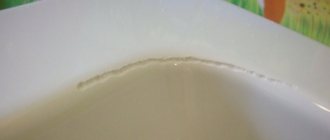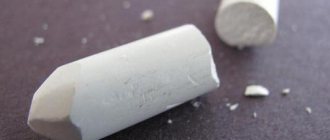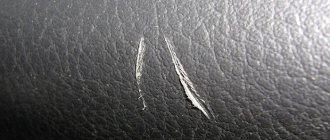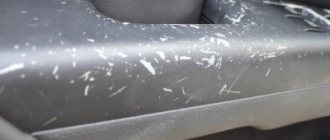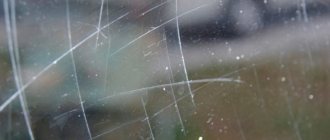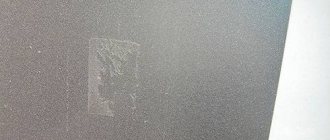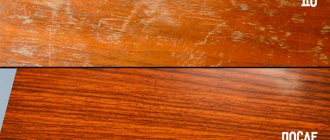Glossy kitchens are stylish and beautiful, but not entirely practical.
During use, scratches will certainly appear on the shiny surface of the cabinets. Somewhere the knife will come off unsuccessfully, or too much effort will be applied when trying to remove drops of fat. As a result, cabinet facades lose their former attractiveness and shine.
Read the article on how to safely remove scratches from a glossy kitchen surface.
Cleaning products that housewives can use
When choosing what to clean a kitchen made of glossy plastic with, give preference to liquid products used to clean glass. Such compositions cope well with greasy stains. Fingerprints, stains and splashes can be easily cleaned with special sprays. Their components are completely harmless to shiny facades and do not affect the saturation of shades.
- wipe dry with a soft cloth (microfiber can be used);
- apply wax-based polish;
- rub with a dry cloth.
This will create a repellent layer for grease and moisture, and will also enhance the shine of the gloss.
Helpful information
Tips for removing scratches from a glossy kitchen:
Restoration should begin immediately after the defect is discovered.- Before treatment, the surface is degreased. This will allow the polish to go on smoother and last longer. Alcohol can be used for this purpose. Solvents are not allowed to be used on gloss.
- To give the headset shine, first rub it with a flannel cloth and then with a dry paper napkin.
If you are interested in how to remove small and deep scratches from various surfaces and objects, take a look at this section.
What products should not be used?
The choice of options for how to wash a glossy kitchen without streaks is so huge that it’s difficult to figure it out. First of all, it is advisable to immediately remember which products should be avoided. This list includes:
- all kinds of solvents, for example, acetone;
- alcohol;
- preparations containing soda or salt;
- ammonia;
- nitroglycerine;
- polymer resins.
When choosing how to clean a glossy kitchen from grease, it is better to abandon the melamine sponge or use it with extreme caution. It perfectly removes marker marks, but can harm varnish and acrylic surfaces.
Before use, the melamine sponge must be moistened and wrung out thoroughly. This will soften it, preventing it from leaving scratches on the surface of the furniture.
Next, wash the glossy kitchen, or rather the contaminated areas, lightly pressing the sponge. If you press too hard, the melamine will break down and scratches will form on the surface. When the process is completed, you need to wipe the glossy facade with a damp cloth.
So, a glossy kitchen can cause a lot of trouble for its owners. In particular, you need to know how to clean glossy kitchen facades, what products to use and how to use them correctly. However, with proper care, the furniture will delight its owners with a brilliant, original appearance. And the variety of stylish solutions allows you to purchase a glossy kitchen for any budget and taste.
Acrylic plastic
It tolerates wet cleaning well and can be treated with polish. It does not fade in the sun, does not fade and is resistant to mechanical stress.
Contaminants from such a surface can be removed quite easily. These facades can be polished when defects appear on them.
However, it is also sensitive to the chemical composition of cleaning products.
Under no circumstances should you wash them with aggressive detergents, as you may lose the shine of the glossy façade.
What not to wash a glossy kitchen
You need to take care of a glossy kitchen very carefully so as not to scratch or spoil the surface. It is forbidden:
- Wash facades with plain water. Especially if the furniture is made of MDF or chipboard and covered with thin plastic or PVC film. When exposed to moisture, materials may delaminate. After cleaning, the surface must be wiped with a dry cloth;
- Clean with hard brushes and abrasive sponges, as they will scratch the glossy finish. It is better to use only soft materials, prevent dirt from drying out, and clean regularly so that you do not have to forcefully scrub off the layer of grease;
- Use household chemicals that contain abrasive particles. For example, powders leave scratches and indentations, which in the future will become a place for fat accumulation;
- Use products that contain chlorine, alcohol, acetone, ammonia, as they leave cloudy white stains. Nitroglycerin does not wash away stains well, leaving streaks; alcohol discolors the coating;
- Wash the gloss with a melamine sponge, as it removes the shine from the set, making it faded. You should also not use a steam cleaner;
- Use some household chemicals - Pemolux, Comet, as they contribute to clouding and yellowing.
To wash a glossy kitchen, you can use a suede car rag - it does not leave marks, streaks, and absorbs moisture well. The wipes are made from synthetic materials, but their properties resemble leather. The rag is stored in a special container or in water to prevent it from drying out. Facades are wiped without using chemicals.
Please make the situation public!
Since the end of May of this year, I began to actively conduct raids to clear areas of garbage. I am writing about everything to the Committee for the Improvement and Greening of our city. I am writing complaints (and statements) about numerous illegal dumps and that Kamaz trucks from an organization unknown to me are dumping garbage in the river. Brewery, as well as in some places on the river. Barnaulki.
wide board for wall decoration
And so, after the Tolka report with my participation, they began, apparently, to take revenge on me. (Because of this, by the way, I fell off the network and stopped writing about the raids I was conducting).
But the pressure intensified. Today, under threats of criminal prosecution and promises to put me in jail, two men also called me (in the morning and literally before I started writing this post) and demanded that I stop my activities.
Source
Anti-scratch products
Oddly enough, in the kitchen you can also find a number of products that are suitable for restoring furniture with scratches.
Nuts
If you rub a defect with a walnut, it will be almost impossible to notice it. You can also grind the nuts into flour, add a little olive oil, and rub the damaged area. It is better to repeat this procedure once a week.
mixture for leveling concrete floors
Using Walnut to Treat Scuffs
Mayonnaise
Fatty mayonnaise can be used to repair scratches on unpolished wood. A drop of the product is placed on the furniture, gently rubbed in, after a day the product is sanded and rubbed with a rag.
Small scratches can be disguised with mayonnaise
Lemon
Lemon is used together with vegetable oil. The juice of this fruit is mixed equally with sunflower or other oil, smeared on the defective area on wooden furniture, and polished with a lint-free cloth.
Making polish from lemon and vegetable oil
Using welding, you can mask small abrasions and shallow scratches. Brew a bag of black tea with a small amount of boiling water and leave for 20 minutes until the liquid becomes rich in color. Then soak a cotton pad in it and apply it to the scratch for a couple of minutes. This method will not work for light-colored furniture.
You can treat scratches on a wooden surface with a tea bag.
Instant coffee
A tablespoon of coffee should be diluted with water to make a thick paste. Place the mixture on the damaged area of the wood product, avoiding contact with other areas. After 5 minutes, remove excess with a cloth.
Coffee grounds for scratches
Vinegar with olive oil
This product is great for light polished furniture. Mix 50 g of oil and a teaspoon of table vinegar. The composition is applied to the abrasion, left for a day, then wiped the area with a rag.
Olive oil and vinegar for scratches
Fish fat
One capsule of fish oil is enough to repair a small defect on a wooden surface. The liquid is rubbed into the damaged area, left for 2 hours, then the greasy mark is removed with a rag.
You can treat scuffs on furniture with fish oil.
